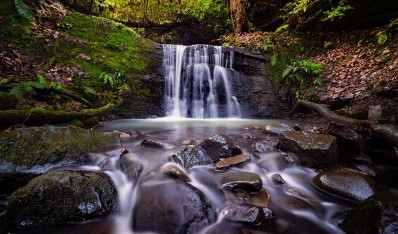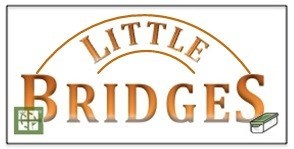
Little Bridges #2187 - Carriden Falls
Little Bridges is a national cache series intended to take cachers on nice walks to interesting little footbridges. The Little Bridge at this cache is sited in the heart of Carriden Glen, which was part of the estate of Carriden House nearby. The glen is full of lush vegetation, and there's almost a jungle feel here, with the formal gardens that were once located around here having overgrown. As Bo'ness is bracketed east and west by two impressive estates (Carriden and Kinneil), I've placed a Little Bridges cache in the glens next to both estates (see Little Bridges #2158 - GC95ERR).
The Glen rises high on either side around Carriden Burn which flows in an easterly direction into a deep and picturesque waterfalls. It is met by the Muirhouses Burn just to the north-west of the old Carriden stable complex and then heads northerly to the coast at Burnfoot where there is a sandy beach at 'The Crookies'. The bridge lies a minutes walk to the south of the falls, which are definitely worth taking a look at as you pass through the glen.
Carriden House
The cache stands a couple of dozen yards from the current boundary wall of Carriden House, once the centre of a sprawling estate from the coast to some distance inland. Carriden House stands on the 100ft contour at the top of an escarpment overlooking the southern shore of the Forth Estuary. The house and estate has changed hands many times, but Carriden estate is first recorded as being owned by a Sir William de Veteriponte in the 14th Century. A large house would have been the centre of the estate, but not the one currently seen - it seems to have been created in the early 17th Century (1602) on the site of the original building. Due to the extensive Roman remains in the area the 'new' house incorporated pieces of Roman architecture that were unearthed during its building and then repurposed. At this time the village settlement of Carriden was in the immediate area around the house, and there was a parish church and churchyard as well as a graveyard within a few yards of the house.
During extensive further works on the house in 1682, more Roman remains were encountered, including the head of an eagle carved on stone ,which was subsequently built into the fabric of the new wing. For two centuries afterwards the house and estate seemed to pass through the hands of a succession of high-ranking military men, often in colonial service.
Also about the time of the house's late 17th Century facelift, the size of the population in the village at Carriden began to decrease as families moved to the growing port at Bo’ness, or to the shore at Bonhardpans near Bridgeness. Carriden on its hill, which had been secure in an age of violence, was inconvenient as a place of seaborne business during the growing peace and prosperity. It increasingly became a working estate of the wealthy, and a status property, rather than the centre of a settlement.
A string of residents added to the house and estate, notably in the early 19th Century, such that when it was sold in the first half of that century it extended to 500 acres. It had by then become a very grand residence with new formal drives, ornate outbuildings and gatehouses, a fishery, and its own piers at the nearby shore. Eventually, absentee landlords and a failed repurposing as a power-generating station, meant the estate contracted to just the house and immediate gardens, but it is still an impressive residence in its own right today.
Carriden Falls

Finding The Cache
This is a Letterbox Hybrid Geocache, which means that you will use GPS and some extra directions to find the cache. Head to the published coordinates, which are for the bridge. On the stream-side path heading north towards the coast, on the same side as Carriden House, there's a long fallen tree just off the path about 25-27 metres away. The fallen tree is on the left hand side of the path (heading north to the coast) and lies on the ground pointing down the bank towards a big tree and the stream. The cache is at the stream-end of the fallen tree. This is a popular path so beware of being muggled.
Two Parking waypoints are provided for this cache, both are a distance away from the cache (500 metres approx) as there are no immediately convenient parking areas due to the private roads nearest to the cache. One parking waypoint is located near the northern caches in this series, and the other for the southern caches.
About Letterbox Geocaches
Letterbox Geocaches are based on an older kind of container search, called 'Letterboxing'. Because letterboxing began in 1854, before GPS existed, the finder follows written instructions to discover the container. Each letterbox contains a logbook, and a rubber stamp. When letterboxers find the container, they stamp the logbook with their personal stamp, and also stamp their own notebook with the stamp from the letterbox as a souvenir of their visit. The stamp and logbook remain in the letterbox for the next visitor to use.
Letterbox Geocaches combine GPS and the stamps of letterboxing to form a distinct cache type. As with all geocaches, this cache type must include some element of GPS usage. In addition, the cache description can contain written instructions to guide geocachers to the container. A Letterbox Hybrid container must contain:
- A rubber stamp - the 'signature' of the specific cache.
- A logbook to sign, and often they will also include a separate 'stampbook' to record the signature stamps of finders
Some letterbox caches also have an inkpad, but as they don't hold up well in the field it's better to bring your own. The important thing to remember is that the letterboxing stamping activity is optional and you can always treat them just like a normal cache if you prefer.
The rubber stamp is not a trade item and must stay within the cache.

The Little Bridges series was started by cacher Stanthews in 2009 to highlight small footbridges in remote parts of Wiltshire. Since then the series has been expanded by others all over the country and starting to spread fast. There is a stats listing, so you can see how many Little Bridges you have found, you can find it here: - https://www.littlebridgesseries.co.uk. If you would like to add to the series, please go to this site, on the tab Get Involved click number request and fill in the form. To qualify, the bridge must be a foot bridge too small for vehicles, please make sure your title exactly matches “Little Bridges # xxxx then the name” including spaces so it will get picked up and added to stats list.